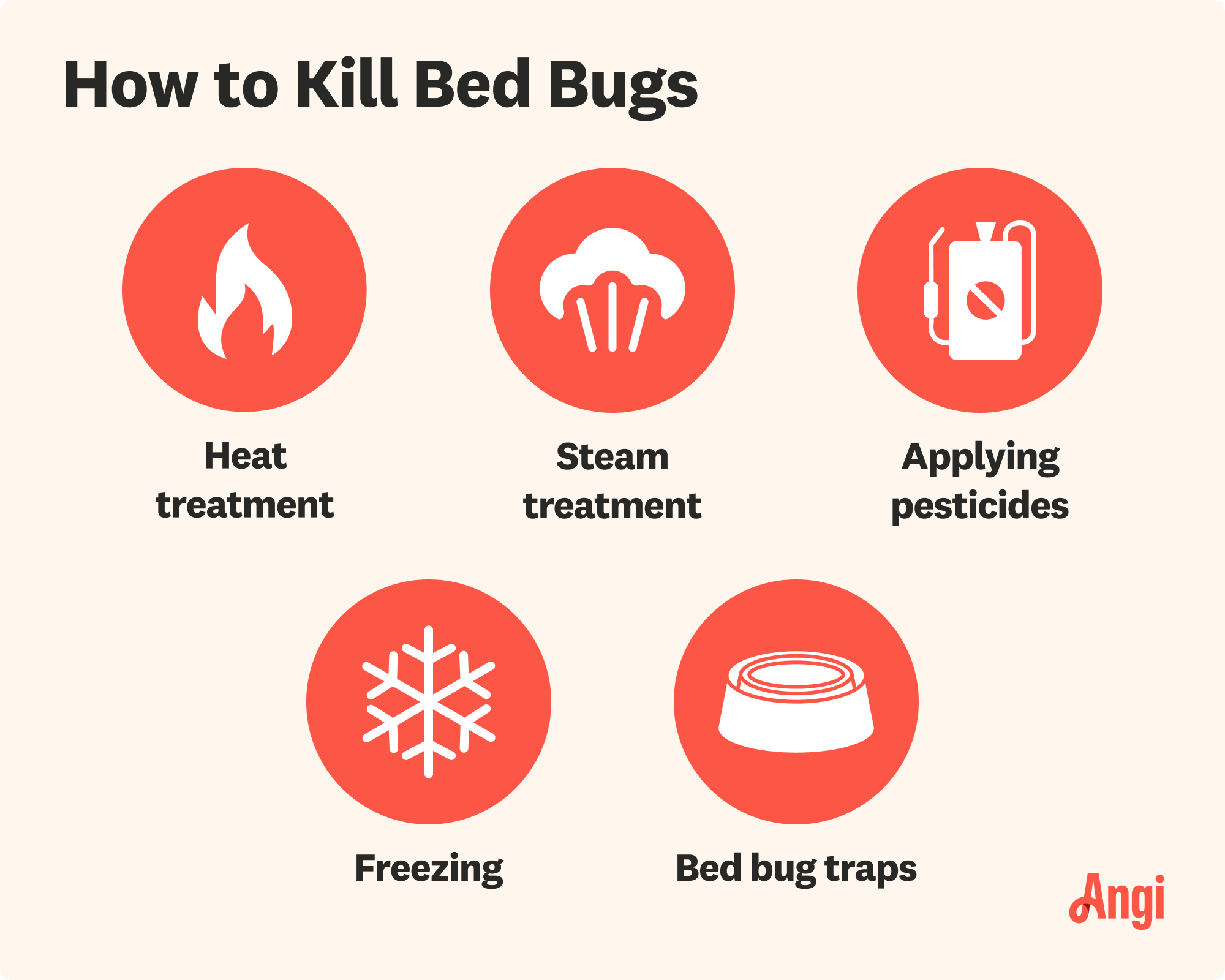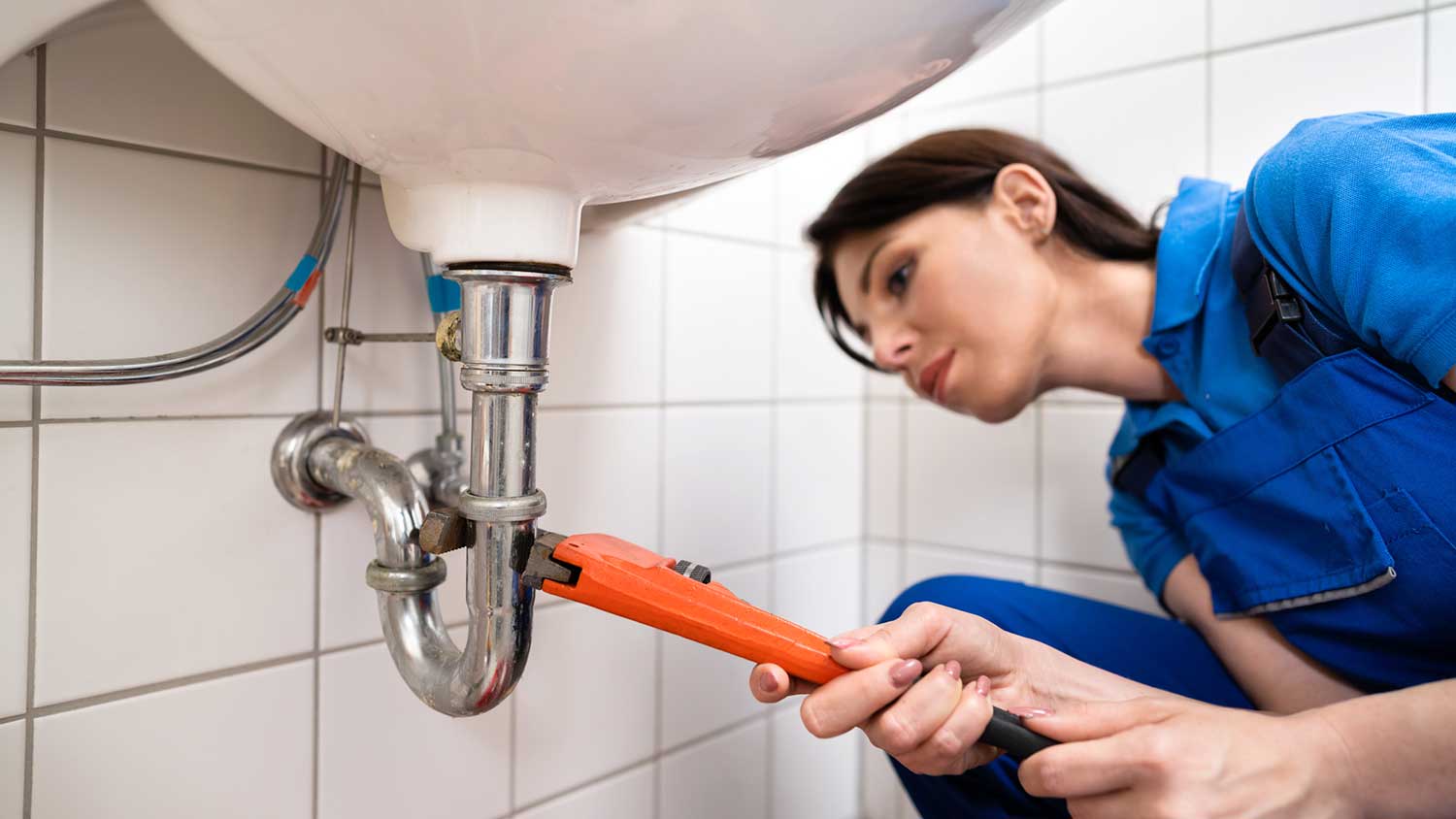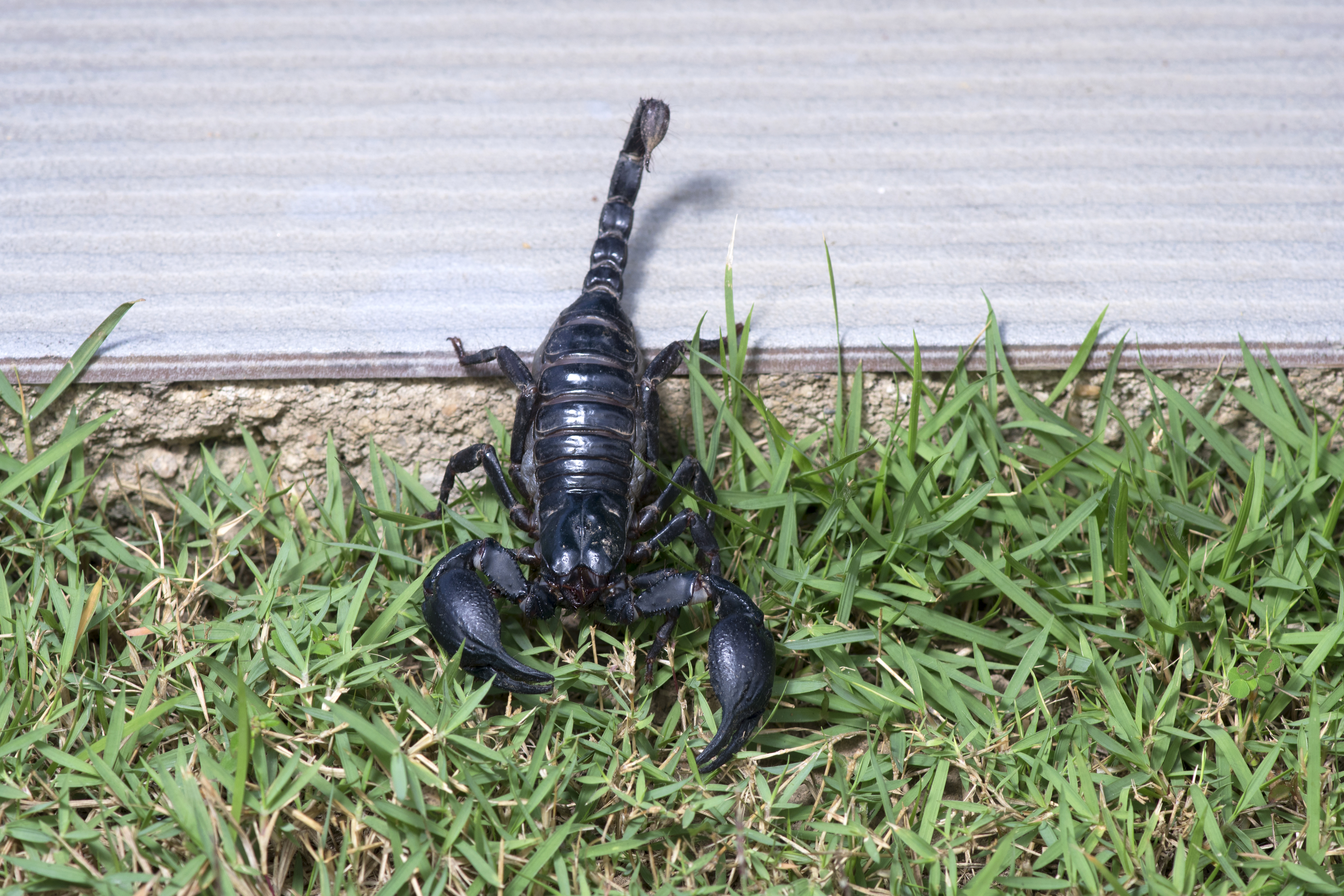
The average roach exterminator cost is between $100 and $600, depending on the species, infestation severity, and home size. Read on for a cost breakdown.
Bite back against a bed bug infestation


Professional bed bug extermination costs between $1,000 and $4,000, depending on the extent of the infestation and your home’s size.
Getting rid of bed bugs on your own is possible—but it often takes weeks or even months, and you’ll likely need to use several different treatment methods to see results.
DIY efforts such as vacuuming, laundering, steaming, and using diatomaceous earth or traps can help, but they’re rarely enough for a serious infestation.
A licensed exterminator uses targeted treatments, such as heat chambers, commercial-grade steamers, and regulated pesticides, to reach hidden bugs and unhatched eggs.
After treatment, pros can advise on what to discard, how to monitor for returning bugs, and what steps to take to prevent reinfestation.
Bed bugs are one of the most notorious and cringe-inducing household intruders, and discovering them in your home can feel overwhelming. But don’t panic: You can learn how to get rid of bed bugs using one or a few DIY removal methods that have proven successful against these discrete but uninvited pests. Let’s take a look at how to get rid of bed bugs and prevent them from coming back.
If your bed bug problem doesn't resolve itself after implementing DIY removal methods, it's time to call in a professional exterminator. Don't hesitate to take pest control action to prevent the infestation from growing.
A common misconception of bed bug infestations is that they only happen in dirty, unhygienic places. The truth is that bed bugs are highly adaptable and can inhabit any space, regardless of cleanliness. They don’t seek out dirt, dampness, or filth—they only need blood to thrive.
Bed bugs are opportunists that seek out places where they can hide and feed on the blood of unsuspecting people. They move fast in search of food, so the main cause of bed bugs is cross-contact between infested linens, clothing, luggage, furniture, or other soft items. If you are in the midst of a bed bug infestation, here are a few common scenarios that could have caused it:
Bed bugs hide inside used furniture, clothing, handbags, backpacks, or other soft items.
The bugs spread in hotels, motels, apartment complexes, or other multi-unit environments.
A house guest brought them in their luggage or clothing.
The bugs found their way into your luggage while traveling.
Before you start treating a bed bug infestation, it’s important to identify all potential areas where they could be lurking. If you miss any spots, the bugs could continue to multiply—and you’d have to repeat the treatment process.
Be sure to check the most common bed bug hiding places, including:
Mattresses and box springs
Headboards and bed frames
Couches
Chairs
Curtains
Baseboards
Laundry baskets
Suitcases and backpacks
Closets
Carpets
Car seats
Pest control needs will change with the seasons due to temperature. In the spring, when water temperatures rise mosquitoes hatch, occasional invaders seek shelter within structures during the fall, and freezing temperatures in the winter drive rodents inside of structures.

Once you’ve confirmed a bed bug problem in your home, there are several low-cost DIY solutions to try. Here are the top methods to try before bringing in a professional exterminator.
Isolate mattress materials, exposed clothing or blankets, furniture, and other items that are infested or have been exposed. Remove all infested items and seal them in plastic bags. Avoid moving these items throughout your home to minimize the chance of spreading the bugs.
Arrange for new sleeping or outfit plans so people stay away from infected items. Reschedule visits or events with friends and family to reduce risk of bed bug exposure.
Launder bedding, clothing, and linens on high heat for around an hour, drying them thoroughly. This method can kill bed bugs or eggs. Don’t forget about common items like pet beds, laundry holders, and spare blankets near the infestation where bed bugs can often hide.
Vacuum regularly as long as the infestation continues, immediately emptying and cleaning the canister outside.paying close attention to cracks, crevices, and furniture. Dump the vacuum bag or bin quickly to remove any bugs.
Exposure to hot water or steam cleaners may kill bed bugs at all life stages, but it’s not always effective. The thermal death point of bed bugs is 118 degrees Fahrenheit to kill off the insects.
This method works best for killing bed bugs isolated to one area, as you have to apply direct steam for about 20 minutes.
Eradicating bed bug eggs will require 90 minutes of heat contact.
You can purchase a portable heating device, specifically made for this unfortunate task, that allows you to place infested items inside the racks and heat to 120 degrees Fahrenheit. These devices typically cost about $310.
However, professional exterminators have access to more powerful, honed-in methods of heat for bed bug treatment. They can seal up larger items like mattresses or sofas and heat them to the required levels, killing bed bugs inside. Professionals also have whole-room heaters that can perform the same task, but these are rarely used inside homes where they can damage belongings.
Steam treatment is one of the most effective in-home ways to get rid of a limited bed bug infestation, and there’s no toxic pesticides to worry about. Steam comes out well above the temperatures necessary to kill bed bugs, so there’s less need to “hot box” your furniture or bed while still killing bugs and their eggs.
Purchase or rent a home steamer with nozzles that can treat many different materials and reach up to 220 degrees Fahrenheit. Professional exterminators often have their own dedicated steamers for the job.
Use the steamer on exposed mattresses, chairs, couches, cars, and similar belongings.
Don’t use a steamer on more delicate fabrics or items that could be damaged by high-pressure steam.
Use steam in combination with our other methods: The sum of the parts is greater than the whole when dealing with bed bugs.
Freezing items to kill bed bugs can be successful, but it takes time and most homes don’t have the proper means to do it.
The EPA recommends leaving items in temperatures of 0 degrees Fahrenheit for at least three days.
Since most home freezers aren’t capable of reaching that low temperature, other bed bug treatments are often preferred.
There are over 300 EPA-approved pesticides for bed bugs that can help kill off a stubborn infestation, including:
Pyrethrins and pyrethroids
Desiccants
Neonicotinoids
Cold-pressed neem oil
Chlorfenapyr
Insect growth regulators (IGRs)
Keep in mind that there are several risks and benefits of using bed bug pesticides. Also, bed bugs are often resistant to pesticides, so you shouldn’t count on this method alone to get rid of them.
With that said, if you decide to go this route, here are some tips to keep in mind:
Apply chemical sprays directly on infestation areas.
You can use contact-kill sprays on live bugs, but it won’t eradicate bed bug eggs or hidden bugs.
Always research the product side effects before applying to your home, and remove children and pets from the area during the duration of treatment.
You can also sprinkle dust-based products like diatomaceous earth in the infested area, but you must wear protective gear to avoid ingesting or inhaling it. This method is not foolproof, and it will likely require several rounds of treatment. Reserve this option for minor infestations.
After your primary treatment is finished, look for traps clearly labeled for bed bugs at your local home improvement store.
Place these traps around beds and furniture, where they’ll play two important roles.
Wait for traps to catch any straggler bed bugs before they can lay eggs and start the infestation process.
Clear the traps by disposing of the dead bugs, removing them completely from your home.
Use the traps to monitor bed bug presence and see if you need to take further steps or contact the pros for new options.

Unfortunately, many bed bug treatments don’t work on severe infestation, no matter how much money or time it seems to save. These treatments are rarely worth the effort:
Many traditional bug sprays: Bug sprays can be effective when sprayed directly on live bed bugs, but they can’t reach bed bugs hiding deep in fabric lining. They aren’t guaranteed to kill eggs. You also don’t want these toxic liquids on your home furniture if you can avoid it.
Essential oils: Some essential oil mixtures may irritate bed bugs, but they are unlikely to kill them and won’t make them leave. In fact, some scents appear to even attract bed bugs.
Sticky traps: Sticky traps aren’t designed for bed bugs and are unlikely to take effect. If you’re buying traps, look for traps that are specifically designed for bed bugs, not general insect traps.
Rubbing alcohol: Rubbing alcohol may kill bed bugs on contact, but it’s not very effective and it’s a bad combination with fabrics, which it can stain.
Fumigation or bug bombs: Fumigation is a poor option for bed bug removal, especially for DIYers. Bug bombs are very unhealthy and cannot kill tenacious bed bugs that dig down deep to avoid the fumes. Sometimes professionals will recommend fumigation for a very bad bed bug infestation, but it’s unusual and part of a broader treatment strategy.
Mothballs: Contrary to popular hopes, mothballs don’t do much to dissuade bed bugs.
Ultrasonic devices: Ultrasonic emitters make lots of promises about getting rid of bugs, and none of them are backed by evidence. Avoid these gadgets.
Pepper, herbs, any kind of seasoning: Rumors encourage the use of seasonings like mint or cayenne pepper to get rid of bed bugs. Alas, these tales aren’t true. Don’t sprinkle any seasonings on your bed or furniture to get the bugs out.
You need to hire a professional to address your infestation when you spot signs of an active bed bug infestation, such as seeing live bugs, getting bites overnight, or seeing bed bug droppings. It’s best to hire a professional exterminator at the first sign of these pests to avoid them multiplying and spreading further.
In many cases, you can get rid of bedbugs yourself if the infestation isn’t too widespread. However, if it’s a serious infestation or you want the peace of mind that the bugs are gone, hiring a local exterminator is the way to go. Pest control pros have the right skills, tools, and knowledge to inspect and treat the infested area safely. Plus, they can likely eradicate the infestation faster and more permanently than DIY treatments.
The typical cost for home bed bug extermination is $1,000 to $4,000. Hire a local bed bug removal company to kill the bed bugs in your home and stop the infestation in its tracks.
After heating, steaming, cleaning, freezing and laying traps for remaining bed bugs, there are a few final steps to take to help prevent a future infestation.
Throw away infested items. Don’t try to give them away, and contact a waste removal service for removal of larger items.
Check your traps weekly to monitor bed bug presence. Some bed bugs in the first week or so may show up as remaining eggs hatch. Otherwise, bed bugs should eventually die out entirely.
You can also set “interceptor” traps or small containers posted under the legs of the bed with a layer of slippery talcum powder to capture bugs trying to climb back in.
Use caulk to seal any cracks or gaps the bed bug inspection uncovered. It’s unlikely that bed bugs enter through these weak spots, but other pests can.
Seal items you can’t heat or freeze tightly in plastic bags and store them away in cupboards, closets, or the attic. Wait at least one year before opening them again.
Once you’ve beaten the bed bugs, prevention is key to keeping your home bug-free. These are the most important tips to prevent bed bug infestations:
Keep luggage away from bed linens while traveling.
Inspect mattresses for signs of bed bugs while traveling.
Launder secondhand clothing, linens, and other soft items before use.
Inspect secondhand furniture and non-washable used items before bringing them into your home.
Declutter your home to limit potential hiding places for bugs.
Vacuum your home frequently to suck up any stray bugs.
Consider adding a protective shield to your mattress.
Wash clothes and other soft personal belongings immediately after traveling.
From average costs to expert advice, get all the answers you need to get your job done.

The average roach exterminator cost is between $100 and $600, depending on the species, infestation severity, and home size. Read on for a cost breakdown.

How much does a gnat exterminator cost? The answer depends on the method of treatment and the level of infestation. Find out what plays into your budget.

Bats may have their benefits, but you don't want them taking up residence in your home. This guide will help you understand bat removal costs.

Water bugs are pesky creatures that may enter your home in search of water and food. Learn how to prevent water bugs from entering your home.

Rodents can wreak havoc on your house if they build a nest under the porch. Learn how to get rid of rodents under the house and keep them from coming back.

Scorpions are creepy pests that you definitely don’t want near your living space. Find out how to keep scorpions away from your house.